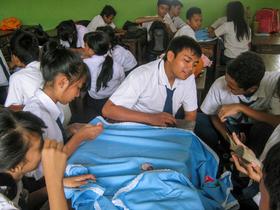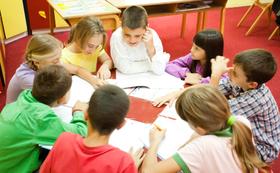Serving 309 students in grades Prekindergarten-6, Lame Deer School ranks in the bottom 50% of all schools in Montana for overall test scores (math proficiency is bottom 50%, and reading proficiency is bottom 50%).
The percentage of students achieving proficiency in math is ≤5% (which is lower than the Montana state average of 37%). The percentage of students achieving proficiency in reading/language arts is ≤5% (which is lower than the Montana state average of 46%).
The student-teacher ratio of 12:1 is equal to the Montana state level of 12:1.
Quick Facts (2025-26)
- Grades: Prekindergarten-6
- Enrollment: 309 students
- Student-Teacher Ratio: 12:1
- Overall Testing Rank: Bottom 50% in MT
- Math Proficiency: ≤5% (Btm 50%)
- Reading Proficiency: ≤5% (Btm 50%)
- Science Proficiency: ≤10% (Btm 50%)
- Source: National Center for Education Statistics (NCES), MT Dept. of Education
Top Rankings
Lame Deer School ranks among the top 20% of public schools in Montana for:
Category
Attribute
Percent Eligible For Free Lunch
School Overview
Lame Deer School's student population of 309 students has stayed relatively flat over five school years.
The teacher population of 25 teachers has grown by 38% over five school years.
Grades Offered
Grades Prekindergarten-6
(No virtual instruction)
(No virtual instruction)
Total Students
309 students
Gender %
Total Classroom Teachers
25 teachers
School Motto
Everything "Morning Stars"- A place where our students shine
School Rankings
Lame Deer School ranks within the bottom 50% of all 696 schools in Montana (based off of combined math and reading proficiency testing data).
The diversity score of Lame Deer School is 0.10, which is less than the diversity score at state average of 0.40. The school's diversity has stayed relatively flat over five school years.
Overall Testing Rank
#690 out of 696 schools
(Bottom 50%)
(Bottom 50%)
Math Test Scores (% Proficient)
≤5%
37%
Reading/Language Arts Test Scores (% Proficient)
≤5%
46%
Science Test Scores (% Proficient)
≤10%
37%
Student-Teacher Ratio
12:1
12:1
American Indian
95%
10%
Asian
n/a
1%
Hispanic
4%
6%
Black
n/a
1%
White
n/a
77%
Hawaiian
n/a
n/a
Two or more races
1%
5%
All Ethnic Groups
Participates in the National School Lunch Program (NSLP)
Yes
Eligible for Free Lunch
100%
42%
Eligible for Reduced Lunch (08-09)
5%
10%
School Statewide Testing
School District Name
Source: National Center for Education Statistics (NCES), MT Dept. of Education
Profile last updated: 02/09/2025
Frequently Asked Questions
What is Lame Deer School's ranking?
Lame Deer School is ranked #690 out of 696 schools, which ranks it among the bottom 50% of public schools in Montana.
What percent of students have achieved state testing proficiency in math and reading?
≤5% of students have achieved math proficiency (compared to the 37% MT state average), while ≤5% of students have achieved reading proficiency (compared to the 46% MT state average).
How many students attend Lame Deer School?
309 students attend Lame Deer School.
What is the racial composition of the student body?
95% of Lame Deer School students are American Indian, 4% of students are Hispanic, and 1% of students are Two or more races.
What is the student-teacher ratio of Lame Deer School?
Lame Deer School has a student ration of 12:1, which is equal to the Montana state average of 12:1.
What grades does Lame Deer School offer ?
Lame Deer School offers enrollment in grades Prekindergarten-6 (No virtual instruction).
What school district is Lame Deer School part of?
Lame Deer School is part of Lame Deer Elementary School District.
School Reviews
Review Lame Deer School. Reviews should be a few sentences in length. Please include any comments on:
- Quality of academic programs, teachers, and facilities
- Availability of music, art, sports and other extracurricular activities
Recent Articles

School Vouchers: Updated Pros and Cons (2025 Review)
Comprehensive 2025 analysis of school vouchers, weighing benefits and challenges for families, funding, outcomes, and policy directions.

Benefits and Drawbacks of Homework in 2025
Explore updated 2025 insights on homework鈥檚 benefits, drawbacks, mental health impact, best practices, and policy trends in U.S. public schools.

Charter Schools vs Public Schools 2025: Key Differences & Trends
Explore updated 2025 insights comparing charter schools vs public schools, enrollment, academic outcomes, funding, and real-world examples for families and educators.





